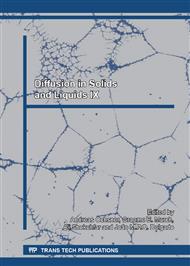p.189
p.193
p.199
p.205
p.211
p.217
p.223
p.228
p.233
Effect of Voltage Parameters on Surface Morphology of Micro Arc Oxidized Cp Titanium
Abstract:
In this study, commercially pure titanium (Cp-Ti) was micro arc oxidized in an alkaline solution by using a bipolar power supply capable of applying square voltage pulses. In the oxidation process, voltage level and numbers of positive and negative pulses were varied, and the effect of such parameters on surface and cross sectional morphology of the coatings were evaluated. In characterization works, X-ray diffraction analysis (XRD), scanning electron microscopy (SEM), coating thickness measurements and surface roughness measurements were employed. Results generally showed that coating thickness and surface roughness greatly depend on the voltage level in that higher voltage levels give thicker coatings and rougher surfaces. When the number of successive positive voltage pulses is increased, more uniform surface appearance with well distributed and equal sized micro pores are obtained up to 400 V of positive voltage. When the oxidation is performed for positive and negative pulse numbers of 10-1 at higher voltage levels, the average pore size of the coating thickness increased and the number of pores decreased.
Info:
Periodical:
Pages:
211-216
Citation:
Online since:
May 2014
Authors:
Keywords:
Price:
Сopyright:
© 2014 Trans Tech Publications Ltd. All Rights Reserved
Share:
Citation:


